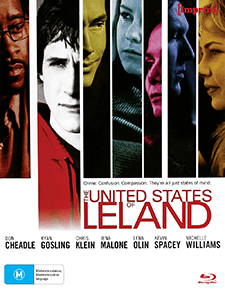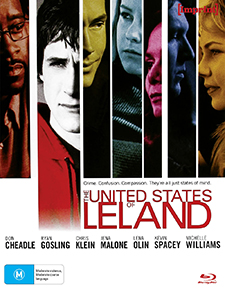United States of Leland, The (Blu-ray Review)

Director
Matthew Ryan HogeRelease Date(s)
2003 (July 5, 2024)Studio(s)
Paramount Pictures (Imprint Films/Via Vision Entertainment)- Film/Program Grade: B
- Video Grade: A
- Audio Grade: A
- Extras Grade: B
Review
[Editor’s Note: This is a Region-Free Australian Blu-ray import.]
The United States of Leland is a disturbing film about a murder committed with no apparent motive by an intelligent, popular young man who defies societal sensibilities. It explores why we seek answers to unanswerable questions and why the murderer is the only one who justifies his heinous action.
The story begins after Leland P. Fitzgerald (Ryan Gosling, The Fall Guy) has murdered the mentally challenged brother of his ex-girlfriend Becky (Jena Malone, Love Lies Bleeding). Leland is the son of successful author Albert T. Fitzgerald (Kevin Spacey, Superman Returns), a cold man who hasn’t seen his son in seven years. Leland offers no insight, no reason, no explanation, and no thought about what he’s done and never feels he has to. He’s actually despondent about the death. Writing him off as a sociopath would be a simple way to explain why he would murder an innocent, vulnerable individual. Instead, the film takes us on a journey through Leland’s mind and soul.
In Juvenile Hall, Leland is assigned to counselor Pearl Madison (Don Cheadle, Hotel Rwanda). Their conversations are extremely revealing and soon Pearl, a frustrated writer, sees in them a best-selling book. As his focus shifts from helping Leland psychologically to pumping him for information, he circumvents prison policy to get extra time with the boy. Pearl gets thrown off balance, however, by Leland’s astute criticism of his lifestyle and failure to scrutinize the inherently dishonest and self-serving actions he takes in his private life.
Pearl has an awkward meeting with Leland’s father, whose arrogance and disdain for others have isolated him. Pearl tries to provoke the senior Fitzgerald by accusing him of being the cause of Leland’s abhorrent mindset and behavior. Fitzgerald, however, recognizing that Pearl is trying to elicit information for a book, refuses to talk and vows to sabotage the aspiring author’s efforts.
The screenplay by director Matthew Ryan Hoge is intriguing. He sets up the primary question early on—Why did Leland kill the boy?—and we assume that a backstory will provide information pointing to a motive, however twisted. Yet that never happens, and Leland remains an enigma. Leland is mild-mannered, soft-spoken, polite, and bright. He doesn’t fit the usual profile a murderer, and his complete lack of a motive or explanation make him an object of fascination. Should we hate him? Is it his abandoned upbringing that should be blamed? Is the crime more heinous because it seems random and senseless?
Gosling is excellent in a role that demands consistency, intensity, and empathy. His eyes convey warmth and gentleness, his manner is restrained, and he often seems surprised by all the attention the murder has attracted. As he’s led from a police car into court, he passes through rows of onlookers and reporters hoping to get a glimpse of him. Gosling’s scenes with Cheadle, in particular, are riveting as much as for what Leland says as for what he doesn’t say.
Cheadle strikes the right balance as the overreaching prison counselor Pearl. He comes across as genuinely well-meaning and sincere—until he sees his sessions with Leland as material for a book and we see his opportunism trump his vocational responsibility. Cheadle has a very communicative face, especially his eyes, which widen when Pearl is excited and lower when confronted by his superior about breaking rules.
As Leland’s father, Spacey doesn’t have a lot of screen time but he definitely makes an impression and it’s hard not to keep his character in mind. A loner, he avoids eye contact, speaks condescendingly, makes no attempt at common politeness, bears a sense of entitlement because of his best-selling author status, and is perceptive in discovering what drives a person. His a failure as a father possibly has led him to find solace in liquor. I just wish Spacey had more to do; he’s sadly underused.
The supporting cast is excellent and consists of Michelle Williams, Chris Klein, Lena Olin, Kerry Washington, and Martin Donovan.
Director Hoge has taken on a tough topic—senseless murder. Movies dealing with murder usually have a satisfying resolution. The killer is either caught or killed and the reasons for the killing are made clear. Things are conveniently tied up at the fadeout. The United States of Leland doesn’t offer us that option. Instead, Hoge presents a puzzle and asks the viewer to join in putting it together. In the end, there may be a number of missing pieces but a fuller picture of the characters will have emerged.
Other films that have focused on senseless murders include The Bad Seed, Summer of Sam, Frenzy, Badlands, Frailty, and The Silence of the Lambs. It’s a common theme in movies but The United States of Leland gives it an original spin. Is Leland an incipient serial killer whose tendency is nipped in the bud, a crackpot, or something more complex? Trying to find the answers is part of the film’s appeal.
The United States of Leland was shot by director of photography James Glennon on 35 mm film with spherical lenses and presented in the aspect ratio of 1.85:1. The Blu-ray from Imprint Films features an aspect ratio of 1.78:1. Clarity and contrast are excellent. Complexions are well-rendered. There are no visual imperfections to hamper or distract from enjoyment. Details, such as the notebook Leland uses in prison, patterns in clothing, objects and furnishings in Pearl’s office, trees and grass in a park, prison fencing, and insignias on police cars are well delineated. Gosling is filmed a lot in close-up, as if the camera is trying to get a more intimate sense of who Leland is. The color palette is unusually bright, considering the film’s dark subject, and avoids the cliched look of deep, dark shadows and somber tones. The bright orange of the prison jumpsuits, the steely blue corridors of the juvenile facility, the lush greens of trees and lawns, and the red of Leland’s jacket offer an abundance of primary hues.
There are two soundtrack options: English 5.1 DTS-HD Surround and English LPCM 2.0 Stereo. English SDH subtitles are an available option. Dialogue is clear and distinct throughout. Gosling narrates via voiceover from Leland’s journal entries. He speaks in a soft voice that never varies throughout the film. With dialogue dominating, there are only a few sound effects of note—police sirens, ambient prison noise, and a scream. The score by Jeremy Enigk is neither overly dramatic, as in many thrillers and mystery films, nor merely a means to transition from scene to scene. It underscores the drama and helps to build suspense.
Bonus material on the Region-Free Blu-ray release from Imprint Films include the following:
- Audio Commentary by Scott Harrison
- Theatrical Trailer (2:23)
Audio Commentary – Film historian Scott Harrison notes that The United States of Leland deals with sadness, loneliness, depression, isolation, and grief “in a very stark and unflinching way.” It’s a melancholic film made during a metaphorically bland period, a time when cinema was trying to find a new identity. Shot in 28 days, the film was first shown at the Sundance Film Festival in 2003 and released a year later in the U.S. at a time that saw the proliferation of sequels and franchise films. The “emptiness and coldness” of the film is integral to the fabric of the story. There’s a disconnection from feelings. The role of Pearl was based on director Matthew Ryan Hope’s experience working in a juvenile incarceration facility. Ryan Gosling felt it was one of the best scripts he had read up to that point. He had to isolate himself to get into character. The voice of Leland was clearly defined in the script. Don Cheadle, too, was excited by the material. Commentator Harrison quotes from a few contemporary reviews, including that of The New York Times’ A.O. Scott, who complained about its chronologically fractured structure. That very structure is common on TV shows. The film is noted for having the viewer “step in a slightly different direction.” Often, lives are defined by one action that lands them in a juvenile facility. Just as it finished shooting, parents of autistic children put a petition up on the Internet condemning the film for exploiting autistic children. There’s little concern for the murdered boy. He’s simply the key plot point. The film fails to draw out its characters with conviction, and doesn’t deliver satisfactorily on an emotional level.
Rather than being presented in broad swaths of black and white, The United States of Leland depends on shades of grey and the viewer’s own interpretation. Ryan Gosling etches a memorable portrait of a troubled young man, and performances overall are excellent. Director Hoge builds tension through editing and performance. At film’s end, Leland remains an enigma. The coldness of the story undermines an emotionally satisfying payoff. The film assembles clues and presents them. Now it’s up to us to decipher their meaning.
- Dennis Seuling

